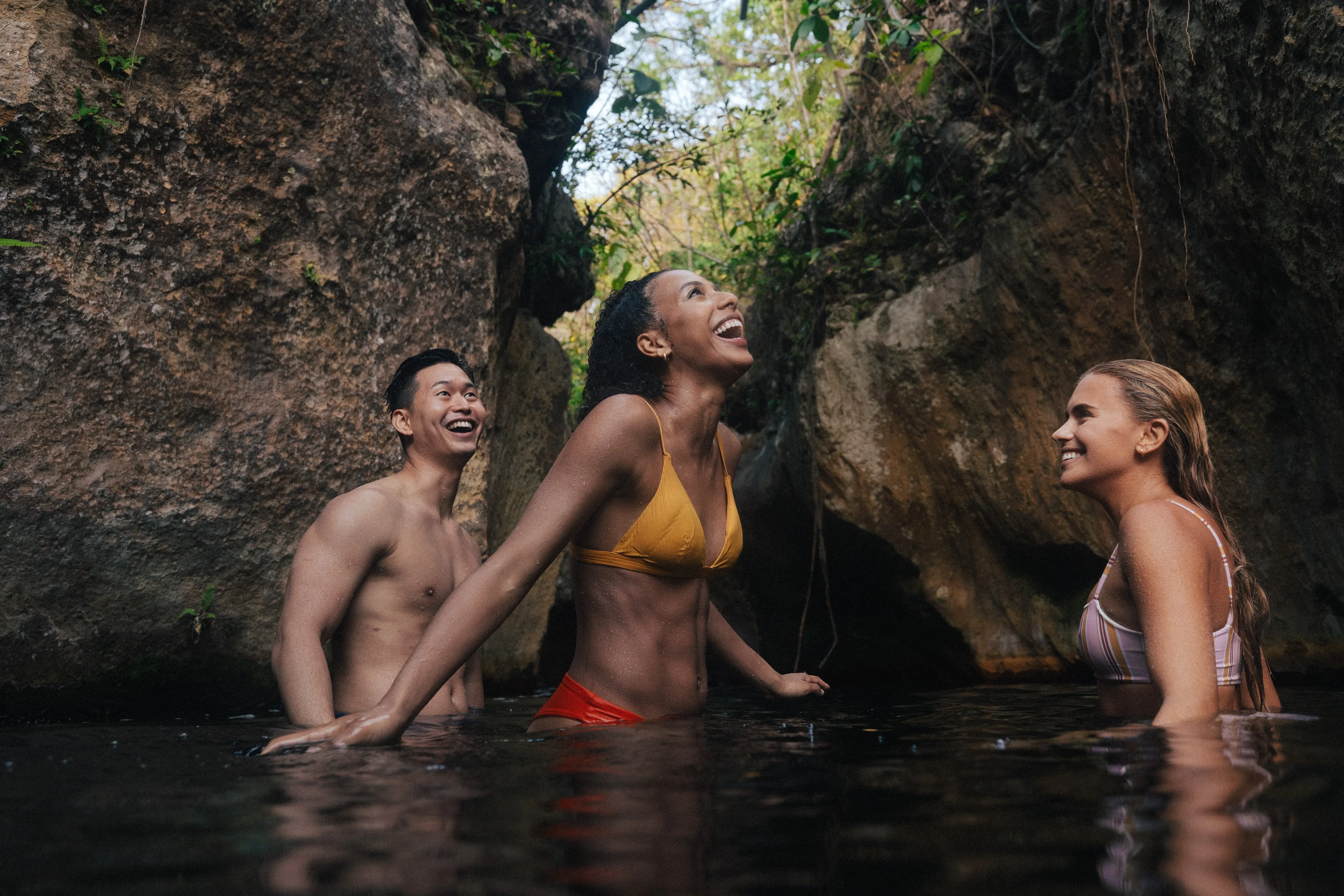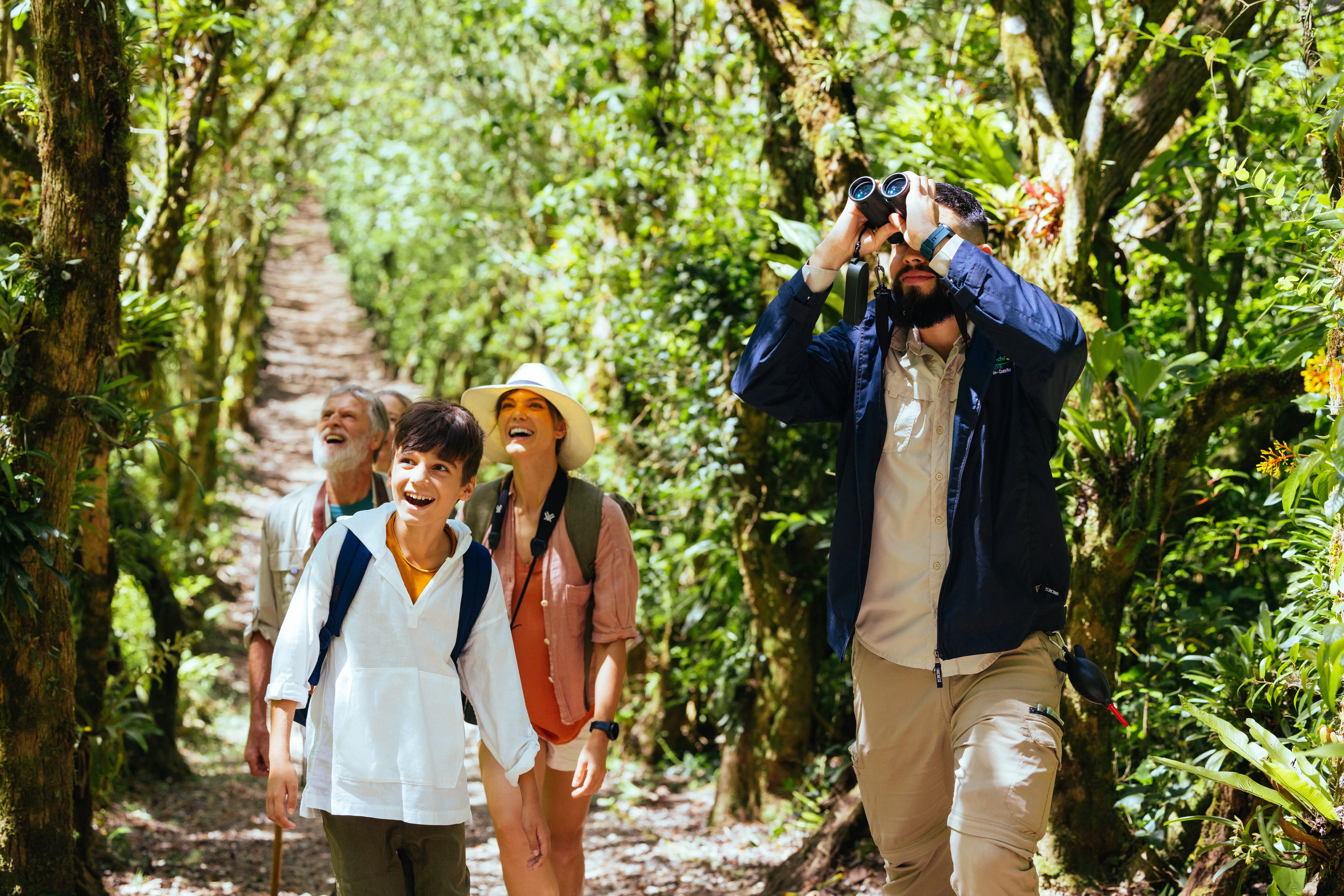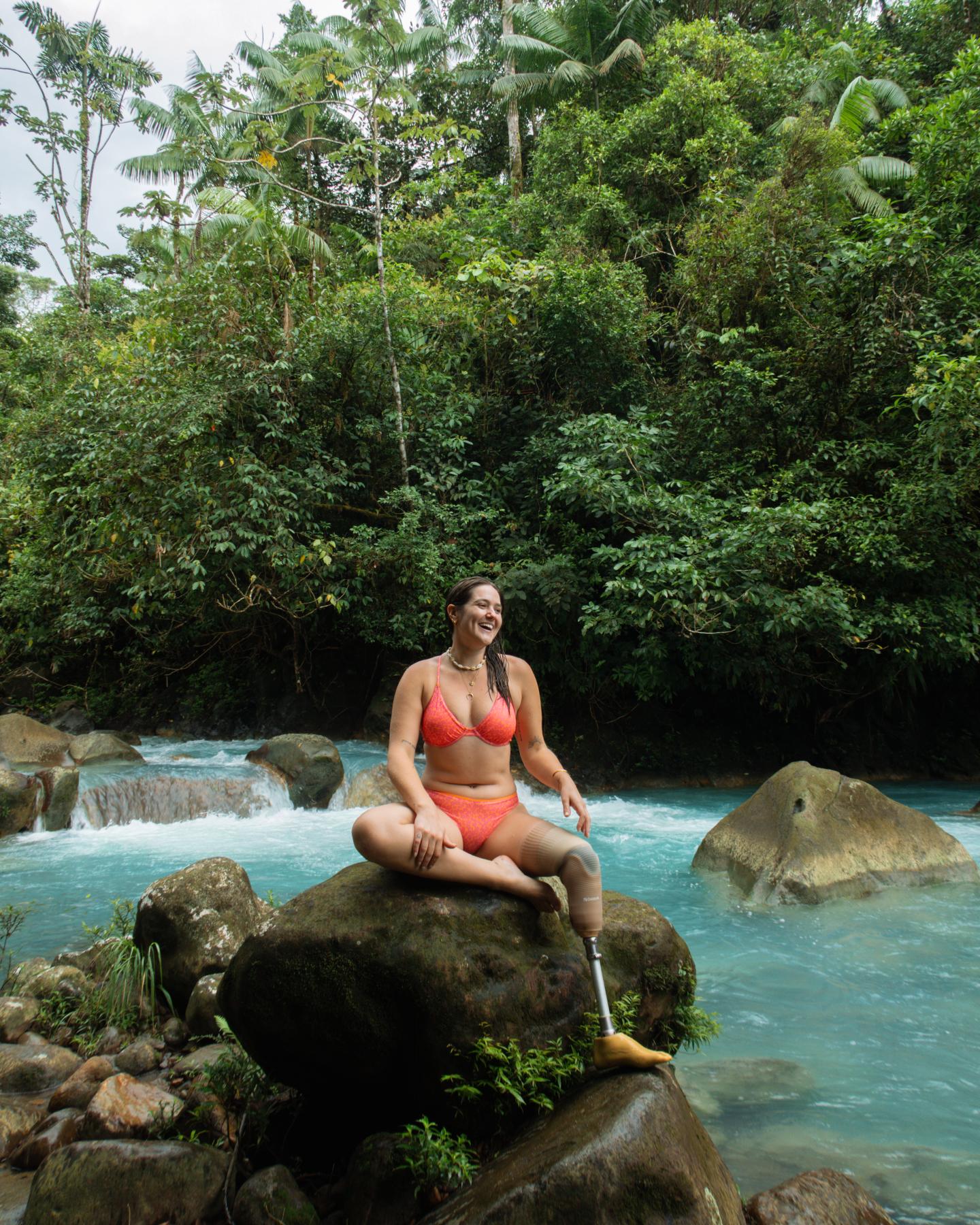I’ve travelled to 40 countries so far, and my lifelong goal is to see as many corners of the world as possible. But no matter where I go, there’s one country I keep coming back to: Costa Rica.
This small but mighty country is endlessly diverse. One trip might be about adrenaline and adventure, the next about slowing down and living pura vida. Every time I think I’ve seen it all, Costa Rica shows me a new side of itself and leaves me wanting more.
I’ve been four times, and I’m already planning my fifth visit. Each trip has given me a completely different way of experiencing the country.
Costa Rica truly lives up to its reputation of having something for everyone, not just families, backpackers, or luxury seekers, but adventurers of all abilities, including those of us navigating the world with a disability.
My name is Allison, I was born missing the lower half of my left leg at birth. I love to swim, snowboard, paddleboard, hike and travel. I’ve become a disability advocate to share my story and encourage others to experience life, regardless of their disability or insecurities. Here are some of the types of trips I've taken across this endlessly fascinating country.
A Road Trip Across the Country
One of my favorite adventures was renting a car and road-tripping across Costa Rica. I was surprised by how simple it was; you don’t need an international driver’s license. With Waze as my co-pilot, navigating the winding roads felt easy, and the freedom to stop in little towns along the coast made the journey unforgettable.
There was one drive I’ll never forget, between La Fortuna and Monteverde. We came over a ridge and suddenly to my right were farm animals grazing, to my left the mountains rising steeply, and in front of me, on a crystal-clear day, miles and miles of green stretching to the horizon. It was one of the most breathtaking landscapes I’ve ever seen, the kind of view that makes you stop and realize why you travel in the first place.
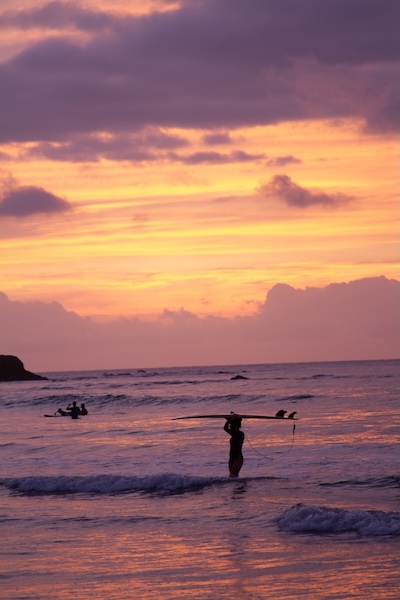
Beachfront Stays & Accessibility
Over the years I’ve stayed in beach towns like Puerto Viejo de Talamanca, Jacó and Tamarindo, and what struck me most was how accessible many of them are.
As an amputee, I naturally notice things like ramps, sidewalks and pool access that others might overlook. In Jacó, I was surprised to find curb cuts on sidewalks on almost every corner and even met a group of retirees from Toronto who had moved there because of how disability-friendly it is. They told me, “Canada was great, but here we feel freer, healthier and still supported.” That conversation stuck with me … it made me wonder if Costa Rica might someday be where I’d want to retire, too.
Many beachfront resorts had ramps into restaurants, shallow-to-deep pool entries and even advertised beach mats so wheelchair users could get onto the sand. Knowing those options existed made me (and my community) feel not just included but welcomed.

Above the Clouds & Into the Rapids
Costa Rica is also where I’ve had some of the biggest adrenaline rushes of my life.
Zip-lining in Monteverde was unlike anything I’ve ever done. Extremo Park has roughly 16 ziplines, some stretching high above the canopy, and we went during the rainy season when the forest below was at its greenest. I strapped on my GoPro, launched into the sky and couldn’t stop saying out loud, “Oh my God, this is so beautiful,” over and over again. Looking down at the endless green, imagining the diversity of life below, I felt like I was flying through another world.
Then there was white-water rafting in La Fortuna. I joined a group from my hostel to tackle Class 4 rapids. Growing up near the Rockies in Alberta, I’ve rafted before, but what stood out to me here was how inclusive Costa Rica felt.
As an amputee, I’ve sometimes faced skepticism when I show up for extreme sports. But in Costa Rica? No one questioned me. No one doubted whether I could handle it. They just saw me as another adventurer ready for the ride. That kind of respect is empowering. (Though I always recommend giving your guide a heads-up about your disability—safety first!)
Even the jungle hikes, while not always fully accessible, gave me moments of pure wonder. Some trails have stairs, though many viewpoints are reachable, and the rewards are unforgettable: waterfalls, emerald pools, wildlife peeking from the trees. Costa Rica constantly reminds me that adventure isn’t about limits, it’s about finding your own way in.
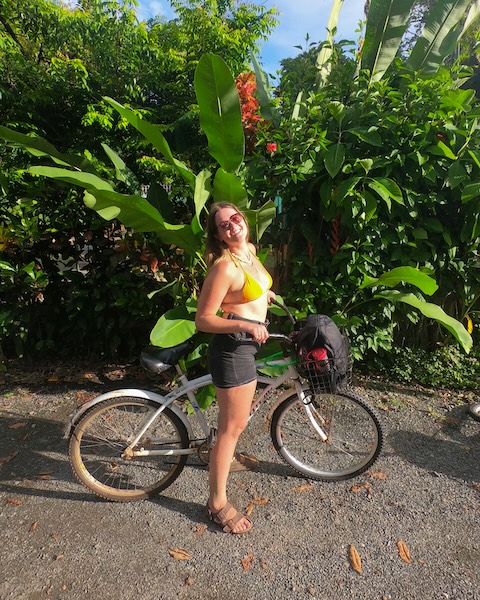
Slowing Down in Puerto Viejo
Adventure is only half the story. Costa Rica is also where I’ve experienced some of my most peaceful, grounding moments.
In Puerto Viejo de Talamanca, a small town on the Caribbean coast, life moves differently. The pura vida lifestyle comes alive there in a way I’ve never felt anywhere else. Between the white-sand beaches, black-sand beaches and the local Jaguar Rescue Center, it’s already magical. But what truly makes Puerto Viejo unforgettable is its people and their energy. They are some of the friendliest people I’ve ever met while travelling.
One afternoon I sat alone on Playa Negra, journaling as the waves caressed the shore. The air smelled of salt and earth, and for the first time in a long time, I felt completely in tune with my mind, body and soul. Coming from a high-paced environment back home as a national athlete, I hadn’t realized how much I needed that pause. Puerto Viejo gave me that recharge: a reminder to slow down, to breathe, to simply be. At that moment, I found the true meaning of pura vida.
Traveling as an Amputee in Costa Rica
People often ask what it’s like traveling Costa Rica with one leg. For me, most of the time, it’s been surprisingly smooth. But what stands out most are the encounters I’ve had with people.
Once, while walking to the beach, a Costa Rican man called out and asked if he could have my prosthetic because he was missing his leg, too.
Another time on the beach, a local man asked about my story and then told me he had coached for the Asociación Deportiva de Surf Adaptado, which competes all around the world. He wanted to teach me how to surf and asked if I thought my prosthetic would stay on when crashing in the waves. That moment reminded me of what sport does best: It connects us, builds bridges and shows what’s possible.
What I love about Costa Rica is that people aren’t phased by my disability. Instead, they lean in. They want me to try things in their country, to show me how much it has to offer. That sense of being welcomed and supported is rare, and it’s one of the reasons I’ll keep returning.
What’s Next: Learning to Surf
Even after four visits, there are still places I haven’t explored: Nosara, Sámara, and Santa Teresa are next on my list. These beach towns are famous for their surf culture, and that ties directly into my next big goal: learning to surf with my prosthetic leg.
I’ve tried once before and failed miserably, but something in me knows I’m ready to try again. Surfing is balance and leg strength, yes, but as someone who snowboards in Canada, I know I have what it takes. And I can’t think of a better place to start than Costa Rica, where the beginner waves are friendly, the water is warm, and the community is supportive.
I can already picture the moment: catching that first baby wave, standing up like I did the first time I snowboarded, heart racing, wind rushing, that exhilarating sense of freedom. More than anything, I imagine the reassurance flooding in, thinking that I was right. That my body, as it is, is capable of anything I set my mind to.
As we age, naturally a lot of people stop trying new things. But I want to keep challenging myself to show others, disabled or not, that all bodies deserve to be celebrated and enjoy life. That we shouldn’t let how our bodies look or move dictate what we are capable of.
Life is short. And as the Costa Ricans say, pura vida.

Practical Travel Tips for Amputees in Costa Rica
Travelling with a disability can sometimes feel daunting, but Costa Rica has surprised me again and again with how doable, and even welcoming, it can be. Here are a few tips from my own experiences:
1. Getting Around
- Car rentals: You can drive with a Canadian license (no international permit needed). Waze is the go-to app for navigation. Roads can be bumpy but doable!
- Public transport: Buses are common but not always accessible; private shuttles are a more comfortable option. Try booking with a colectivo (small bus).
2. Accessibility
- Beaches: Some resorts offer beach mats so wheelchair users can access the sand! Be sure to ask ahead of time.
- Pools: Many hotels have ramps or shallow-to-deep entries instead of only ladders.
- Sidewalks: In towns like Jacó, you’ll find curb cuts that make strolling easier with a prosthetic or mobility aid.
3. Adventure Activities
- Zip-lining & rafting: Let your guide know about your disability for safety, but don’t expect them to hold you back. Costa Rican adventure operators are used to adapting.
- Hiking: Some trails aren’t fully accessible, but many viewpoints are reachable with patience and support. Don’t be afraid to ask locals about the easiest routes.
4. Health Care & Prosthetics
- Bring spare prosthetic liners, sleeves and any tools you might need for adjustments – the humidity and activity can wear them down faster.
- In beach towns, locals are curious and open. Be prepared for heartfelt conversations. (People are curious.)
5. Mindset & Community
- Costa Ricans embrace pura vida – a lifestyle that’s slower, friendlier and all about savoring life. This mindset extends to how they welcome travellers with disabilities.
- Don’t be surprised if people want to include you in things – like when a local coach invited me to try surfing while at the beach.
My biggest piece of advice? Don’t count yourself out. Costa Rica is a place where adventure and accessibility overlap more than you’d expect, and where locals will cheer you on every step of the way (pun intended).
Digital Marketer, Content Creator, Speaker, Model, Traveler, & Paralympian, Allison Lang
